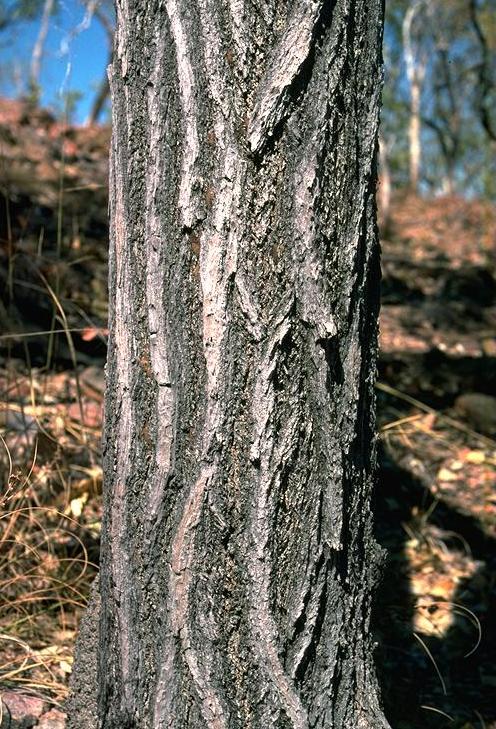Eucalyptus Jensenii on:
[Wikipedia]
[Google]
[Amazon]
''Eucalyptus jensenii'', commonly known as Wandi ironbark, is a species of tree that is 

endemic
Endemism is the state of a species being found in a single defined geographic location, such as an island, state, nation, country or other defined zone; organisms that are indigenous to a place are not endemic to it if they are also found elsew ...
to northern Australia. It has hard, coarse black "ironbark
Ironbark is a common name of a number of species in three taxonomic groups within the genus ''Eucalyptus'' that have dark, deeply furrowed bark.
Instead of being shed annually as in many of the other species of ''Eucalyptus'', the dead bark accum ...
", egg-shaped to lance-shaped adult leaves, flower buds in groups of seven, creamy white flowers and barrel-shaped to conical fruit.

Description
''Eucalyptus jensenii'' is a tree that typically grows to a height of and forms alignotuber
A lignotuber is a woody swelling of the root crown possessed by some plants as a protection against destruction of the plant stem, such as by fire. Other woody plants may develop basal burls as a similar survival strategy, often as a response t ...
. It has hard, rough, coarse black "ironbark" on the trunk and larger branches. Young plants and coppice
Coppicing is a traditional method of woodland management which exploits the capacity of many species of trees to put out new shoots from their stump or roots if cut down. In a coppiced wood, which is called a copse, young tree stems are repeated ...
regrowth have dull greyish green, egg-shaped to elliptic leaves long and wide. Adult leaves are the same shade of dull green or greyish green on both sides, egg-shaped to lance-shaped, long and wide on a petiole long. The flower buds are arranged mostly on the ends of branchlets on a branching peduncle long. Each branch of the peduncle has seven buds, each bud on a pedicel
Pedicle or pedicel may refer to:
Human anatomy
*Pedicle of vertebral arch, the segment between the transverse process and the vertebral body, and is often used as a radiographic marker and entry point in vertebroplasty and kyphoplasty procedures
...
long. Mature buds are pear-shaped to oval, long and wide with a conical operculum. Flowering occurs from January to May and the flowers are creamy white. The fruit is a woody, barrel-shaped to conical capsule long and wide with the valves near rim level.
Taxonomy and naming
''Eucalyptus jensenii'' was first formally described in 1922 byJoseph Maiden
Joseph Henry Maiden (25 April 1859 – 16 November 1925) was a botanist who made a major contribution to knowledge of the Australian flora, especially the genus ''Eucalyptus''. This botanist is denoted by the author abbreviation when citing ...
from a specimen collected near Wandi by Harald Ingemann Jensen and the description was published in Maiden's book ''A Critical Revision of the Genus Eucalyptus''. Wandi is an old gold-mining camp near Pine Creek in the Northern Territory. The specific epithet
In taxonomy, binomial nomenclature ("two-term naming system"), also called nomenclature ("two-name naming system") or binary nomenclature, is a formal system of naming species of living things by giving each a name composed of two parts, bot ...
honours the collector of the type specimen.
Distribution and habitat
Wandi ironbark grows in open forest and woodland, usually on slopes and tablelands but sometimes on flats and near swamps. It occurs in the Kimberley region and Dampier Peninsula in Western Australia and in northern parts of the northern Territory, including onGroote Eylandt
Groote Eylandt ( Anindilyakwa: ''Ayangkidarrba'' meaning "island" ) is the largest island in the Gulf of Carpentaria and the fourth largest island in Australia. It was named by the explorer Abel Tasman in 1644 and is Dutch for "Large Island" in ...
.
See also
* List of ''Eucalyptus'' speciesReferences
{{Taxonbar, from=Q15397801 Eucalypts of Western Australia Trees of Australia jensenii Myrtales of Australia Plants described in 1922 Taxa named by Joseph Maiden